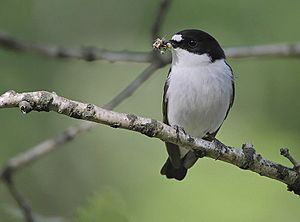Nagshead SSSI facts for kids
| Site of Special Scientific Interest | |

Example: pied flycatcher - woodland supports good populations at Nagshead
|
|
| Area of Search | Gloucestershire |
|---|---|
| Coordinates | 51°46′43″N 2°34′08″W / 51.778738°N 2.568874°W |
| Interest | Biological |
| Area | 120.12 hectare |
| Notification | 1972 |
Nagshead is a special place in the Forest of Dean, Gloucestershire. It's a Site of Special Scientific Interest (SSSI) because of its amazing nature. This means it's a protected area where plants, animals, and habitats are kept safe. Nagshead was officially recognized as an SSSI in 1972.
It's part of the wider Forest of Dean Forest Park. A big part of Nagshead is looked after by the Royal Society for the Protection of Birds (RSPB). The RSPB works with the Forestry Commission to manage this important nature reserve.
Contents
A Look Back: Nagshead's Woodland History
The woodlands in the Forest of Dean have been managed for growing trees for a very long time. This has created many different types of forest. Some areas have oak trees growing on acidic soil. Other parts have richer soil from limestone and Old Red Sandstone rocks. These richer soils allow more kinds of plants to grow.
Nagshead is one of the most important woodlands in the Forest of Dean for nature. It's a great example of a broad-leaved forest. It's also super important for many different kinds of birds. The oldest trees here were planted way back in 1814. These include types of oak trees like pedunculate oak and sessile oak.
Plants of the Forest Floor
The plants growing on the forest floor, also called the understorey, change depending on whether sheep graze there. In areas where sheep do not graze, you'll find a thick layer of shrubs. These are mostly holly and rowan.
Areas where sheep do graze are more open. Here, you might see plants like bramble, bracken, and different types of grass. In some spots, you can find lots of wood sorrel and bluebell.
Ponds, Streams, and Rare Plants
The Cannop Brook flows through Nagshead. Along its banks, you'll find natural areas of woodland, mostly with alder trees. Small ponds and streams also add to the variety of habitats here.
These wet areas are home to some rarer plants. For example, you might spot the heath spotted orchid and the broad-leaved helleborine.
Birdlife: A Haven for Feathered Friends
Nagshead is a fantastic place for birds. It has strong populations of breeding birds like the pied flycatcher, wood warbler, and redstart.
Scientists have been studying how these birds breed at Nagshead for many years. The RSPB manages a special nestbox scheme here. This helps researchers learn more about the birds and provides safe places for them to raise their young.
Insects and Other Small Creatures
The open paths and clearings in the woodland are great for butterflies. You might see beautiful ones like the white admiral, pearl-bordered fritillary, and purple hairstreak. The Cannop Brook also supports many different kinds of insects that live in woodlands.
Protecting Nagshead's Future
Looking after Nagshead means keeping an eye on certain trees like sweet chestnut and sycamore. Experts also watch how the lack of sheep grazing might affect the forest. This is important because the structure of the woodland needs to be just right for some breeding birds to thrive.

